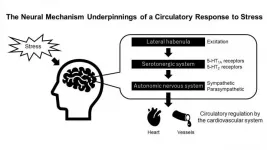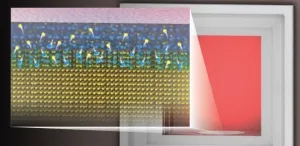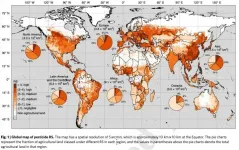This is the conclusion of a new study by the Barcelona Institute for Global Health (ISGlobal), a centre supported by the "la Caixa" Foundation. This study is the first to estimate premature mortality impacts and the distribution by socioeconomic status of multiple environmental exposures related to urban planning and transport in the two cities.
Today, more than half of the global population lives in cities. In Spain, this trend is even more pronounced, with 80% of the population living in urban areas. Madrid and Barcelona are two of Europe's most populous cities, and they also have some of the highest rates of socioeconomic inequality among inhabitants. Recent studies in European cities such as Vienna, Bradford and Barcelona have shown that a considerable proportion of the premature mortality burden--between 8% and 20%--is associated with poor urban and transport planning.
The new study, published in Environmental Research, estimated the impact of non-compliance with international exposure level recommendations for air pollution--fine particulate matter (PM2.5) and nitrogen dioxide (NO2)--as well as excess heat, traffic noise and lack of green space on residents over 20 years of age in Barcelona and Madrid, cities with different urban planning practices. Whereas Madrid is structured around a central nucleus where most economic activity is concentrated, Barcelona is a compact city whose economic activity is distributed across different neighbourhoods.
The study focused on identifying environmental inequities. "Our goal was to identify the population groups that were most exposed and most vulnerable to the effects of poor urban and transport planning," commented ISGlobal researcher Tamara Iungman, lead author of the study. As for methodology, the researchers used a tool called Urban and Transport Planning Health Impact Assessment (UTOPHIA), which was developed by a team at ISGlobal. "We compared current exposure levels with international recommendations and estimated the fraction of preventable premature deaths that could be avoided if we were to comply with those recommendations," explained Iungman.
Attributable Deaths
The findings showed that non-compliance with WHO's exposure recommendations for air pollution, noise, and access to green space, along with excess heat, were associated with 1,037 premature deaths per year in Barcelona (1). Fine particulate air pollution was the exposure associated with the highest premature mortality, accounting for 524 deaths per year (48% of total attributable deaths), followed by lack of green space (277 deaths), exposure to traffic noise (124 deaths), heat (112 deaths) and exposure to NO2 (12 deaths).
For Madrid, the total number of deaths attributable to non-compliance with international recommendations was 902. Lack of green space was the exposure associated with the highest premature mortality (337 deaths per year), followed by excessive heat (244 deaths), NO2 air pollution (207 deaths), PM2.5 air pollution (173 deaths) and noise (148 deaths).
An earlier ISGlobal study attributed 20% of premature mortality in Barcelona to poor urban and transport planning. "The lower values obtained in this health impact assessment of Barcelona and Madrid--7.1% and 3.4%, respectively--could be attributed to the fact that physical activity was not included in this study, in addition to improvements in adverse exposure levels in recent years, as well as the different methodology used to estimate the mortality attributable to noise," commented Iungman.
Differences Between Barcelona and Madrid
With better urban and transport planning, Barcelona could avoid nearly twice as many deaths as Madrid: 72 versus 33 deaths per 100,000 inhabitants. "This difference can be partly explained by the fact that the scientific evidence associates higher mortality with exposure to PM2.5, which is higher in Barcelona; another explanation would be the greater traffic and population density in Barcelona than in Madrid, given that its area represents 1/6th of Madrid's", explained ISGlobal researcher Natalie Mueller, coordinator of the study.
With an annual average of 15 μg/m3, Barcelona exceeded the maximum level recommended by the World Health Organisation (WHO) for PM2.5 (10 μg/m3). For NO2 levels, however, the city's annual average of 37 μg/m3 was under the recommended maximum of 40 μg/m3. Madrid exceeded the WHO recommendations on both counts, with an annual average of 11 μg/m3 for PM2.5 and 42 μg/m3 for NO2.
The main difference between the two cities was in air pollutants. The findings showed higher levels of fine particulate matter in Barcelona and NO2 in Madrid, as well as different spatial distributions: high levels of PM2.5 throughout Barcelona and higher levels of NO2 in the centre of the Spanish capital. "While the main source of NO2 emissions is local motor-vehicle traffic, fine particulate matter has a higher dispersion capacity and is also associated with other combustion sources besides traffic," commented Mueller. "The port and the large industrial areas near Barcelona could influence the high levels of fine particulate matter in the city."
As for green space, the vast majority of the population in Madrid and Barcelona--84% and 95%, respectively--did not have adequate access to these natural environments according to the standards of the WHO, which recommends that people should live within 300 metres of a green space measuring at least half a hectare. This widespread lack of access to green space shows that "in order for green spaces to have health benefits--in addition to mitigating other exposures such as noise and excess heat--it is necessary to consider not only their availability in the city, but also their distribution so that residents can access them on foot," commented Mueller.
With regard to noise, 97% of the population of Madrid and 96% of the population of Barcelona were exposed to traffic noise levels higher than the WHO's recommended values. "Both cities had a considerable mortality burden attributable to traffic noise, which underscores how important it is to reduce noise to improve the health of the population," argued Mueller.
Although there are no specific guidelines for heat, the researchers calculated the temperature corresponding to the smallest number of heat-related deaths in each city: 22.5°C for Barcelona and 21.5°C for Madrid and estimated the impacts of a potential reduction of 1º. "The two cities had similar attributable mortality rates and we found correlations between less green space and higher levels of heat and noise," added Iungman.
Environmental Inequities
The findings show that poor urban and transport planning in Barcelona is associated with higher mortality in census tracts with lower socioeconomic status, whereas in Madrid the attributable mortality burden varied by environmental exposure. Although air pollution, lack of green space and excessive heat are widespread problems in Barcelona, attributable mortality rates were overall higher in the most deprived areas. Thus, populations in the most deprived census tracts had a mortality risk 1.26 times higher than that of the least deprived groups, probably because of an already higher underlying vulnerability.
In Madrid, the most deprived neighbourhoods had higher exposure to PM2.5 and heat than the least deprived neighbourhoods, while the inverse was true for NO2 and noise. This is probably due to the fact that lower socioeconomic population subgroups reside more peripheral and closer to industrial areas, where the cost of living is cheaper -and thus they are more exposed to PM2.5 and heat-, while middle and upper middle socioeconomic population reside in Madrid highly trafficked city center, with greater exposure to NO2 and traffic noise. With respect to green spaces, lack of access affected people of both low and middle socioeconomic status. This pattern was also reflected in its attributable mortality, where only the least deprived areas were the ones having less adverse impacts, probably due to lower underlying vulnerability and better general health status.
Co-author Mark Nieuwenhuijsen, Director of the Urban Planning, Environment and Health Initiative at ISGlobal, commented: "This analysis is in line with previous research showing that people living in more deprived neighbourhoods tend to be more exposed to harmful environmental exposures compared to those living in wealthier areas, although this inequity varies according to the design characteristics and historical development of each city."
"This study shows that environmental exposures have a large impact on premature mortality and underscores the importance of designing cities with health impacts in mind, valuing the specificities of each urban environment and prioritising disadvantaged populations," concluded Nieuwenhuijsen. "Health impact assessments are a powerful tool for guiding policymakers towards cities that are healthy, sustainable and fair for all residents."
INFORMATION:
Reference
Tamara Iungman, Sasha Khomenko, Mark Nieuwenhuijsen, Evelise Pereira Barboza, Albert Ambròs, Cindy M. Padilla, Natalie Mueller. The impact of transport and urban planning practices on health: Assessment of the attributable mortality burden in Madrid and Barcelona and its distribution by socioeconomic status. Environmental Research. March 2021.
https://doi.org/10.1016/j.envres.2021.110988
(1) In order to avoid potential double counting of the effects of the air pollutants, this global number only included PM2.5 impacts, which has a greater strength of association with mortality than NO2. Currently, there is a lack of evidence on the independence of mortality effects for NO2 and PM2.5.




